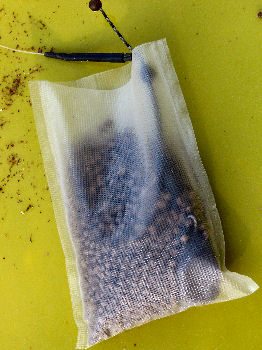What does PVA actually stand for? Most of us have used it, most of us know what it’s supposed to do, but what makes it up? PVA (Poly Vinyl Alcohol) is water soluble synthetic polymer which is oil and grease resistant. First discovered as Poly Vinyl Acetate in 1912 by German scientist Dr. Fritz Klatte, the process then in use was further refined to develop PVA. It has many uses in industry such as a thickener in paints, a reinforcer in concrete, as a fixer when collecting bodily waste samples (especially of stools!) and as a biodegradable backing film in ladies sanitary towels!!
PVA has high tensile strength but this is drastically reduced in the presence of humidity or WATER which is what makes it so useful in angling…..
There is an awful lot of information available to anglers on the internet these days, the uses for PVA can be found on many other blogs, diaries and forums, and every angler will use their PVA in different ways; what I hope to cover are the basic options available today.
PVA Solid Bags
These are available in various shapes and sizes from different manufacturers. Bags are obviously designed to deposit an amount of free offerings as close to the hook bait as possible. Loading the bag ‘properly’ is something which puts many anglers off using them. Angling media in magazines and on television decrees that PVA bags must be completely streamlined, with all edges tucked in, and if they are not, then it is impossible to use them correctly…. Not strictly true, but better casting distances are certainly achievable by placing the lead, baited rig and ‘freebies’ inside the bag in a way which then allows the angler to shape the filled bag into a tightly packed, aerodynamic ball. With little ‘bag flap’ from untidy edges, it is easily possible to cast a filled bag over 100 yards! It is important to remember to puncture the bag a few times before casting with a baiting needle or similar to prevent air becoming trapped in the PVA causing it to float in the upper layers of the water and burst before the rig is properly settled.

Loading a PVA Bag
 PVA Mesh ‘Stocking’
PVA Mesh ‘Stocking’
Also known as cobweb PVA. I use this product more than any other; I like the exceptionally fast ‘melt’ rate, and the fact that it can be used to produce PVA ‘sticks’ also make it a winner in my book. Normally supplied fitted on the outside of a hollow tube, the stocking is knotted at one end before groundbait, pellets, boilie crumb are dropped into the middle of the tube. By forcing the bait down with a plunger, it is possible to make very compact sticks of bait which can be used just by nicking a hook into the mesh before casting, or ingeniously passing the entire hook link through the stick using a baiting needle will completely conceal the terminal tackle as the PVA degrades and deposits the bait on top of the hook link; brilliant! Mesh stocking ‘balls’ can also be catapulted great distances to drop lightweight baits in tight areas at long range (especially if a small stone is added). Filled with biscuits and attached to floating baits, mesh guarantees that the hook bait is surrounded by ‘freebies’. So many options, and definitely my favourite…..
PVA Tape
Mainly used to secure the open end of solid bags prior to casting, tape can be utilised to present ‘stringers’ of just a couple of baits close to the hook or tie a coil of line together if using a deep water zig rig which would be awkward to cast.
PVA String
Again, used to tie a ‘stringer’of baits to the hook to ensure attraction around the hook bait. It needs to be knotted between baits to allow the water to get at the PVA so that it melts effectively.


PVA stringers in action
PVA Nuggets
Very similar in appearance to ‘packing chips’ found in parcels, nuggets are primarily used to protect the hook point on the cast, or to stop the hair tangling around the hook. Over weedy or ‘choddy’ lake beds, nuggets are an ideal way to slow the fall of the hook bait to help it rest on top of any debris. Another benefit to the nugget means that when it starts to dissolve and is released from the hook, it rises to the surface of the water giving an ideal target for baiting up or identifying precisely where the hook bait has settled.
All PVA must be kept completely dry until ready for use. Damp sheds and tackle bags are no friend to PVA and it will quickly shrivel and become useless if not stored properly. Using PVA in the rain is something which can create obvious problems and this needs to be considered!
PVA has many uses and the clever angler will think of many different ways to utilize Poly Vinyl Alcohol to improve the chances of catching that carp of a lifetime. Get it right and you guarantee that the baits are in the best place to trap fish, get it wrong and you end up with a sticky mess and bait everywhere! Try it, and see if can master PVA.

Get it right with PVA and the end result will look like this!








